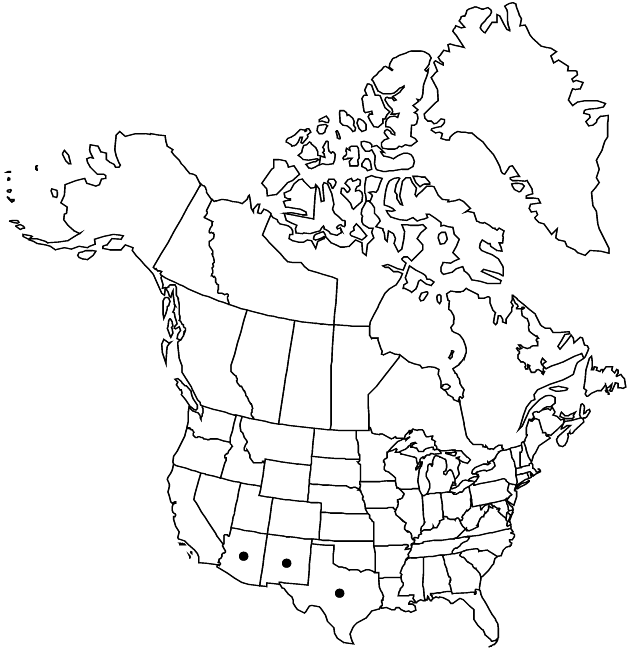Thelesperma longipes
Smithsonian Contr. Knowl. 3(5): 109. 1852.
Perennials or subshrubs (may flower first-year), 20–40+ cm. Cauline leaves mostly crowded over proximal 1/4–1/2 of plant heights, internodes mostly 5–25+ mm; lobes mostly linear to filiform, 5–25 (–45+) × 0.5 (–1) mm. Calyculi of 5 ovate bractlets 1–3 mm. Ray-florets 0. Disc corollas yellow, sometimes with redbrown nerves, throats equal to or longer than lobes. Cypselae 2–3 mm; pappi usually 0, rarely 0.1–0.3+ mm. 2n = 40.
Phenology: Flowering (Mar–)Apr–Oct.
Habitat: Openings in desert scrub, limestone ridges
Elevation: 500–2100 m
Distribution

Ariz., N.Mex., Tex., Mexico (Coahuila), Mexico (Nuevo León), Mexico (San Luis Potosí), Mexico (Tamaulipas)
Discussion
Selected References
None.
Lower Taxa
None.
"broader" is not a number.
... more about "Thelesperma longipes"
introrse +
connate +
herbaceous +
scarious +
absent +
hirsute +
papillate +
corymbiform +
continuous +
decurrent +
lobed +
winged;ribbed;winged;ribbed +
3;8 +
distinct +
herbaceous +
ovate +
stigmatic +
absent +
crowded +
zygomorphic +
longer +
monomorphic +
arcuate +
dimorphic +
outer +
obcompressed +
2mm;3mm +
staminate +
straight +
beaked +
linear-fusiform;4-angled;ovate;orbiculate;oblong;linear;cuneate +
distinct +
proximal +
1;5 +
bisexual +
dispersed +
singly +
indeterminate +
surrounding +
hemispheric;urceolate +
opposite +
lance-linear +
equal +
0.5 cm5 mm <br />0.005 m <br /> (?) +
winged +
scarious +
redbrown +
2-carpellate +
inferior +
attached +
anatropous +
falling +
obovate;oblong +
scarious +
persistent +
falling +
absent +
tough +
thick +
absent +
connate +
persistent +
connate +
falling +
unequal +
equal +
proximal +
Smithsonian Contr. Knowl. +
1852 +
neuter +
absent +
paleate +
flat;convex +
fibrous +
subulate +
exalbuminous +
modifed +
alternate +
branched +
erect +
2-branched +
papillate +
Thelesperma longipes +
Thelesperma +
species +
shorter +
longer +
equal +
equaling +
perennial +
subshrub +